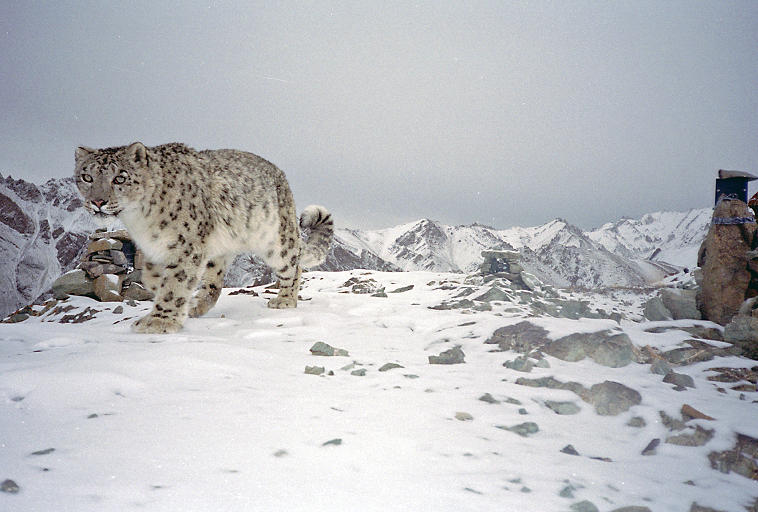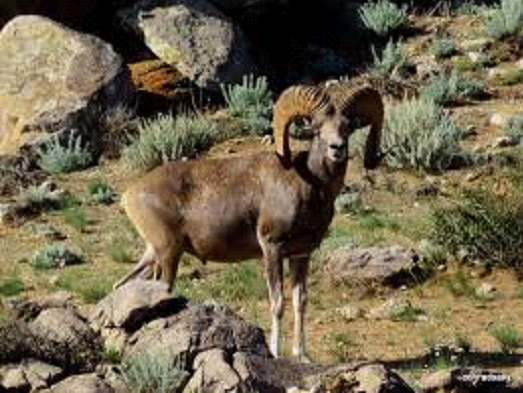- Home
- :
- All Communities
- :
- User Groups
- :
- Conservation GIS
- :
- Documents
- :
- Drones for Snow Leopard Conservation
- Subscribe to RSS Feed
- Mark as New
- Mark as Read
- Bookmark
- Subscribe
- Printer Friendly Page
- Report Inappropriate Content
Drones for Snow Leopard Conservation
Drones for Snow Leopard Conservation

Drones for Snow Leopard Conservation: Detecting and Counting Prey for an Endangered Species in Mongolia
Project investigators:
Dr. Rodney Jackson, Snow Leopard Conservancy, Sonoma, California
Dr. Don Hunter, Rocky Mountain Cat Conservancy, Fort Collins, Colorado
Dr. Bariushaa Munkhtsog, Mongolian Academy of Sciences, Institute of Biology, Ulaanbaatar, Mongolia
Three team members hold UAV Remote Pilot certificates issues by the FAA (USA).
(Photo Below: Dr Rodney Jackson (L) and Dr Bariushaa Munkhtsog with radio collared snow leopard in 2008. Photo Courtesy Snow Leopard Conservancy.) 
(Photo Above: Snow Leopard remote camera image, Ladakh, India) (photos are all courtesy of Dr. Rodney Jackson/Snow Leopard Conservancy)
A videographer, Mr. Ben Hunter (Isaacson School for New Media, Colorado Mountain College) will accompany the team. (Ben Hunter pictured below-center)


Goals and Objectives: The primary goal of this study is to validate drone technology as an effective tool to advance snow leopard conservation by improving the censusing of its large prey species like ibex, argali (photo, right) and blue sheep.
Objective 1: Successfully deploy and test a drone in snow leopard prey habitat.
Objective 2: Test thermography for detecting wild argali and ibex (early morning, late evening).
Objective 3: Test a drone-mounted zoom lens for detecting wild argali and ibex (daylight).
Objective 4: Access ungulate survey accuracy with and without drone support
Request for Support: We are seeking support of fiscal and equipment sponsors from the non-profit and business sectors. This particular request if for software donations from ESRI and Pix4D. To date we have benefitted from support of FLIR for testing the thermal camera XT2 in Colorado (Field test images below)

Problem Addressed and the Challenges Faced: In spite of new non-invasive methods such as remote camera trapping and fecal genotyping, huge challenges remain to answering the question of how many snow leopards (Panthera uncia) remain in the wild. Snow leopards are at risk of extinction (Vulnerable on the IUCN Red Data List) due to retributive killing for killing livestock, poaching, prey depletion and habitat loss/degradation.
This iconic feline is incredibly elusive, rarely sighted and known for occupying home ranges in imposing habitat as large as 1,000 sq km. Snow leopards are sparsely distributed at elevations of 2,000 – 5,400 m in the mountains of 12 Asian countries: Afghanistan, Bhutan, China, India, Kazakhstan, Kyrgyz Republic, Mongolia, Nepal, Pakistan, Russia, Tajikistan, and Uzbekistan
Not surprisingly, wide-ranging snow leopard surveys are difficult and expensive to undertake. Population counts, in particular, will remain so given the snow leopard’s cryptic nature, imposing habitat, and inconstant support among range countries. By contrast, prey surveys are less costly and generally easier to conduct. Whereas prey abundance provides a strong inference to snow leopard abundance, any improvement in censusing wild ungulates advances overall snow leopard conservation.
In general, wild cats survive and persist in areas with a healthy and thriving prey base. Thus, prey condition provides strong inference to the condition and survival of wildcat populations. It is much easier to study the prey of wild cats than it is to detect the cats. Wild prey animals, typically wild ungulates, often frequent open terrain, making them more easily observable. Still, they occupy vast reaches of roadless terrain, thus challenging human observation. Common survey methods call for recording animals observed with binoculars/spotting scope within a specific block of habitat or along a linear transect. Both methods are difficult, expensive, and time-consuming.
In recent years, drones (UAVs) have evolved rapidly and show great promise for improving the ease, accuracy, and cost of ungulate surveys, using visual and thermal on-board cameras.
Project Locations in Mongolia: (1) Ikh Nard Nature Reserve, 300km southeast of Ulaanbaatar in the East Gobi Province and (2) Gobi Gurvansaikhan National Park and Toost Uul Community in South Gobi, some 630 km southwest of the capital city.
 Project Description: We have acquired an industrial UAV (DJI - Matrice 210, photo above) and equipped it with a radiometric infrared sensor (Zenmuse XT2) and the 30X zoom Zenmuse camera. Both sensors offer capabilities to improve upon current censusing methods that rely on visual observation along a 2km wide by 4-5 km long transect. The infrared sensor detects warm-blooded animals especially well early morning late evening. The zoom camera can clearly magnify ungulate-sized animals from 0.75 km distance. After a series of successful tests in Colorado targeted at mountain lion prey we are now ready to test the craft and sensors on snow leopard prey in representative habitat condition. In August, we will conduct test flights in Mongolia’s Ikh Nart Nature Reserve, censusing argali and some ibex (both prey species for the rare snow leopard). Reserve staff, local herders, and collaborators with Denver Zoo have conducted ungulates surveys for the past twenty years, usually around late August. Our project has been fully endorsed by reserve staff, and we will be joining community-based survey teams for a series of tests to collect survey data with and without drone support. An improved census will indicate success.
Project Description: We have acquired an industrial UAV (DJI - Matrice 210, photo above) and equipped it with a radiometric infrared sensor (Zenmuse XT2) and the 30X zoom Zenmuse camera. Both sensors offer capabilities to improve upon current censusing methods that rely on visual observation along a 2km wide by 4-5 km long transect. The infrared sensor detects warm-blooded animals especially well early morning late evening. The zoom camera can clearly magnify ungulate-sized animals from 0.75 km distance. After a series of successful tests in Colorado targeted at mountain lion prey we are now ready to test the craft and sensors on snow leopard prey in representative habitat condition. In August, we will conduct test flights in Mongolia’s Ikh Nart Nature Reserve, censusing argali and some ibex (both prey species for the rare snow leopard). Reserve staff, local herders, and collaborators with Denver Zoo have conducted ungulates surveys for the past twenty years, usually around late August. Our project has been fully endorsed by reserve staff, and we will be joining community-based survey teams for a series of tests to collect survey data with and without drone support. An improved census will indicate success.
 After Ikh Nart, our team will shift to a second location selected for having both snow leopard and ungulate prey, as well as more challenging terrain for test flying. The team will work with reserve staff to replicate methods and test flight operations vetted at Ikh Nart. Several sites in the South Gobi are under consideration, including Toost Uul Community Conservation Area. Dr. Munkhtsog and Bayarjargal Agvaantseren, head of Mongolia’s Snow Leopard Conservation Foundation will make the final selection on the second site. (Image Right, support letter from Ikh Nart Reserve Director)
After Ikh Nart, our team will shift to a second location selected for having both snow leopard and ungulate prey, as well as more challenging terrain for test flying. The team will work with reserve staff to replicate methods and test flight operations vetted at Ikh Nart. Several sites in the South Gobi are under consideration, including Toost Uul Community Conservation Area. Dr. Munkhtsog and Bayarjargal Agvaantseren, head of Mongolia’s Snow Leopard Conservation Foundation will make the final selection on the second site. (Image Right, support letter from Ikh Nart Reserve Director)
A detailed methodology is available upon request.
Supporting Organizations: The key partners in this project are the Snow Leopard Conservancy, the Rocky Mountain Cat Conservancy and the Mongolian Academy of Sciences, Institute of Biology and Irbis Mongolia.
The Snow Leopard Conservancy (SLC) is a well-respected non-profit dedicated to conservation of the rare snow leopard in its native habitat in Central Asia. Its mission aims at ensuring snow leopard survival and conserving mountain landscapes by expanding environmental awareness and sharing innovative practices through community stewardship and partnerships. Dr. Rodney Jackson, widely acknowledged world-leader for snow leopard conservation and research, founded the organization in 2000. For further information, visit SLC’s website: http://snowleopardconservancy.org/. Contact Dr. Rodney Jackson, Founder/Director, Snow Leopard Conservancy (SLC), 75 Boyes Blvd., Sonoma, CA 95476. Ofc: 707-938-1700; Mobile: 707-933-6206; rodney@snowleopardconservancy.org
(Photo Below, World-leading expert on Snow Leopard Dr. Rodney Jackson, Rolex Award winner, National Geographic Author)

The Rocky Mountain Cat Conservancy (RMCC), based in Fort Collins, Colorado, is a non-profit dedicated to wildcat conservation and education with a focus on mountain lions, and involving school-based citizen scientists in monitoring using remote cameras (Website: http://www.catconservancy.org/; Contact Dr. Don Hunter, Science Director, Rocky Mountain Cat Conservancy, 2313 Cedarwood Dr, Fort Collins, CO 80526. Ofc: 970-219-5812; don@catconservancy.org (Photos Below, Don Hunter working on a Mt Lion Radio Collar. Photo courtesy of Dr. Rodney Jackson. Photo2: Rocky Mountain Cat Conservancy Mt. Lion work. Courtesy Rocky Mountain Cat Conservancy)


Dr. B. Munkhtsog is Mongolia’s leading snow leopard expert. He is head of the cat group for the Mongolian Academy of Sciences, as well as Irbis Mongolia, a national non-profit dedicated to the conservation of Mongolia’s wild cats. B. Contact details: Mammalian Ecology Laboratory of the Institute of Biology, Mongolian Academy of Sciences; President of Irbis Mongolia, P. O. Box 256 UB 210349, Mongolia. :Located on Jukov Avenue - 77, Bayanzurkh district, Ulaanbaatar - 51, Mongolia. Tel: (Ofc) 976-11-453583; (Mob) 976-99032176; Fax: 976-11-464067; Email: Munkhtsog isltmon@magicnet.mn (Photo below, from 2015 Interview by Snow Leopard Conservancy. Photo Courtesy B. Munkhtsog)
